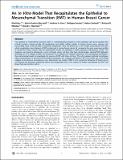Files in this item
An in vitro model that recapitulates the epithelial to mesenchymal transition (EMT) in human breast cancer
Item metadata
| dc.contributor.author | Katz, Elad | |
| dc.contributor.author | Dubois-Marshall, Sylvie | |
| dc.contributor.author | Sims, Andrew H. | |
| dc.contributor.author | Gautier, Philippe | |
| dc.contributor.author | Caldwell, Helen | |
| dc.contributor.author | Meehan, Richard R. | |
| dc.contributor.author | Harrison, David J. | |
| dc.date.accessioned | 2013-11-05T12:31:02Z | |
| dc.date.available | 2013-11-05T12:31:02Z | |
| dc.date.issued | 2011-02-15 | |
| dc.identifier | 23159903 | |
| dc.identifier | 946e8a16-32de-4b21-b46b-fab6a2ab56cd | |
| dc.identifier | 000287369200020 | |
| dc.identifier | 79951871973 | |
| dc.identifier.citation | Katz , E , Dubois-Marshall , S , Sims , A H , Gautier , P , Caldwell , H , Meehan , R R & Harrison , D J 2011 , ' An in vitro model that recapitulates the epithelial to mesenchymal transition (EMT) in human breast cancer ' , PLoS One , vol. 6 , no. 2 , e17083 . https://doi.org/10.1371/journal.pone.0017083 | en |
| dc.identifier.issn | 1932-6203 | |
| dc.identifier.other | ORCID: /0000-0001-9041-9988/work/64034298 | |
| dc.identifier.uri | https://hdl.handle.net/10023/4166 | |
| dc.description.abstract | The epithelial to mesenchymal transition (EMT) is a developmental program in which epithelial cells down-regulate their cell-cell junctions, acquire spindle cell morphology and exhibit cellular motility. In human breast cancer, invasion into surrounding tissue is the first step in metastatic progression. Here, we devised an in vitro model using selected cell lines, which recapitulates many features of EMT as observed in human breast cancer. By comparing the gene expression profiles of claudin-low breast cancers with the experimental model, we identified a 9-gene signature characteristic of EMT. This signature was found to distinguish a series of breast cancer cell lines that have demonstrable, classical EMT hallmarks, including loss of E-cadherin protein and acquisition of N-cadherin and vimentin expression. We subsequently developed a three-dimensional model to recapitulate the process of EMT with these cell lines. The cells maintain epithelial morphology when encapsulated in a reconstituted basement membrane, but undergo spontaneous EMT and invade into surrounding collagen in the absence of exogenous cues. Collectively, this model of EMT in vitro reveals the behaviour of breast cancer cells beyond the basement membrane breach and recapitulates the in vivo context for further investigation into EMT and drugs that may interfere with it. | |
| dc.format.extent | 9 | |
| dc.format.extent | 738686 | |
| dc.language.iso | eng | |
| dc.relation.ispartof | PLoS One | en |
| dc.subject | Breast cancer | en |
| dc.subject | Epithelial to mesenchymal transition (EMT) | en |
| dc.subject | Spindle cell morphology | en |
| dc.subject | Metastatic progression | en |
| dc.subject | Gene expression | en |
| dc.subject | Protein expression | en |
| dc.subject | Basement membrane | en |
| dc.subject | Collagen | en |
| dc.subject | R Medicine | en |
| dc.subject | SDG 3 - Good Health and Well-being | en |
| dc.subject.lcc | R | en |
| dc.title | An in vitro model that recapitulates the epithelial to mesenchymal transition (EMT) in human breast cancer | en |
| dc.type | Journal article | en |
| dc.contributor.institution | University of St Andrews. School of Medicine | en |
| dc.identifier.doi | https://doi.org/10.1371/journal.pone.0017083 | |
| dc.description.status | Peer reviewed | en |
This item appears in the following Collection(s)
Items in the St Andrews Research Repository are protected by copyright, with all rights reserved, unless otherwise indicated.

